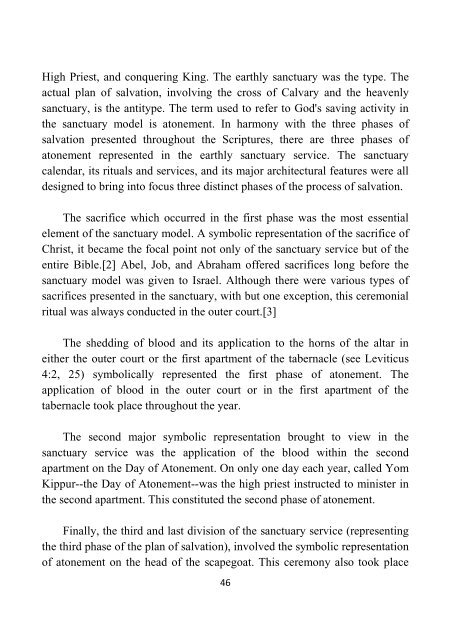Message of the Latter Rain - Kelvin M. Duncan
You also want an ePaper? Increase the reach of your titles
YUMPU automatically turns print PDFs into web optimized ePapers that Google loves.
High Priest, and conquering King. The earthly sanctuary was <strong>the</strong> type. The<br />
actual plan <strong>of</strong> salvation, involving <strong>the</strong> cross <strong>of</strong> Calvary and <strong>the</strong> heavenly<br />
sanctuary, is <strong>the</strong> antitype. The term used to refer to God's saving activity in<br />
<strong>the</strong> sanctuary model is atonement. In harmony with <strong>the</strong> three phases <strong>of</strong><br />
salvation presented throughout <strong>the</strong> Scriptures, <strong>the</strong>re are three phases <strong>of</strong><br />
atonement represented in <strong>the</strong> earthly sanctuary service. The sanctuary<br />
calendar, its rituals and services, and its major architectural features were all<br />
designed to bring into focus three distinct phases <strong>of</strong> <strong>the</strong> process <strong>of</strong> salvation.<br />
The sacrifice which occurred in <strong>the</strong> first phase was <strong>the</strong> most essential<br />
element <strong>of</strong> <strong>the</strong> sanctuary model. A symbolic representation <strong>of</strong> <strong>the</strong> sacrifice <strong>of</strong><br />
Christ, it became <strong>the</strong> focal point not only <strong>of</strong> <strong>the</strong> sanctuary service but <strong>of</strong> <strong>the</strong><br />
entire Bible.[2] Abel, Job, and Abraham <strong>of</strong>fered sacrifices long before <strong>the</strong><br />
sanctuary model was given to Israel. Although <strong>the</strong>re were various types <strong>of</strong><br />
sacrifices presented in <strong>the</strong> sanctuary, with but one exception, this ceremonial<br />
ritual was always conducted in <strong>the</strong> outer court.[3]<br />
The shedding <strong>of</strong> blood and its application to <strong>the</strong> horns <strong>of</strong> <strong>the</strong> altar in<br />
ei<strong>the</strong>r <strong>the</strong> outer court or <strong>the</strong> first apartment <strong>of</strong> <strong>the</strong> tabernacle (see Leviticus<br />
4:2, 25) symbolically represented <strong>the</strong> first phase <strong>of</strong> atonement. The<br />
application <strong>of</strong> blood in <strong>the</strong> outer court or in <strong>the</strong> first apartment <strong>of</strong> <strong>the</strong><br />
tabernacle took place throughout <strong>the</strong> year.<br />
The second major symbolic representation brought to view in <strong>the</strong><br />
sanctuary service was <strong>the</strong> application <strong>of</strong> <strong>the</strong> blood within <strong>the</strong> second<br />
apartment on <strong>the</strong> Day <strong>of</strong> Atonement. On only one day each year, called Yom<br />
Kippur--<strong>the</strong> Day <strong>of</strong> Atonement--was <strong>the</strong> high priest instructed to minister in<br />
<strong>the</strong> second apartment. This constituted <strong>the</strong> second phase <strong>of</strong> atonement.<br />
Finally, <strong>the</strong> third and last division <strong>of</strong> <strong>the</strong> sanctuary service (representing<br />
<strong>the</strong> third phase <strong>of</strong> <strong>the</strong> plan <strong>of</strong> salvation), involved <strong>the</strong> symbolic representation<br />
<strong>of</strong> atonement on <strong>the</strong> head <strong>of</strong> <strong>the</strong> scapegoat. This ceremony also took place<br />
46

















